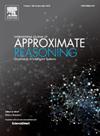具有新中间量词的模糊自然逻辑中对立的分级六边形
IF 3
3区 计算机科学
Q2 COMPUTER SCIENCE, ARTIFICIAL INTELLIGENCE
引用次数: 0
摘要
在这篇文章中,我们将形成一个渐变的对偶六边形,作为渐变彼得森正方形的扩展,结合中间量词的新变化。我们将从古典亚里士多德的对立方及其向六边形的延伸开始。然后,我们引入了Peterson提出并被作者完全形式化的分级对方。我们还引入了量词A few (A little)和几个,并将它们包括在后者中。然后引入了新的量词形式,并研究了它们之间的对立关系、次对立关系、矛盾关系和次(上)交替关系。在了解所有中间量词之间的关系的基础上,构造了对立的梯度彼得森六边形。本文章由计算机程序翻译,如有差异,请以英文原文为准。
Graded hexagon of opposition in fuzzy natural logic with new intermediate quantifiers
In this article, we will form a graded hexagon of opposition as an extension of the graded Peterson's square, incorporating new variations of intermediate quantifiers. We will start with the classical Aristotle's square of opposition and its extension to hexagon. Then we introduce the graded square of opposition that was suggested by Peterson and fully formalized by the authors. We also introduce quantifiers A few (A little) and Several and include them in the latter. Then we introduce new forms of quantifiers and study relations of contrary, sub-contrary, contradictory and sub-(sup-)altern among them. On the basis of the knowledge of the relations among all the intermediate quantifiers we construct the graded Peterson's hexagon of opposition.
求助全文
通过发布文献求助,成功后即可免费获取论文全文。
去求助
来源期刊

International Journal of Approximate Reasoning
工程技术-计算机:人工智能
CiteScore
6.90
自引率
12.80%
发文量
170
审稿时长
67 days
期刊介绍:
The International Journal of Approximate Reasoning is intended to serve as a forum for the treatment of imprecision and uncertainty in Artificial and Computational Intelligence, covering both the foundations of uncertainty theories, and the design of intelligent systems for scientific and engineering applications. It publishes high-quality research papers describing theoretical developments or innovative applications, as well as review articles on topics of general interest.
Relevant topics include, but are not limited to, probabilistic reasoning and Bayesian networks, imprecise probabilities, random sets, belief functions (Dempster-Shafer theory), possibility theory, fuzzy sets, rough sets, decision theory, non-additive measures and integrals, qualitative reasoning about uncertainty, comparative probability orderings, game-theoretic probability, default reasoning, nonstandard logics, argumentation systems, inconsistency tolerant reasoning, elicitation techniques, philosophical foundations and psychological models of uncertain reasoning.
Domains of application for uncertain reasoning systems include risk analysis and assessment, information retrieval and database design, information fusion, machine learning, data and web mining, computer vision, image and signal processing, intelligent data analysis, statistics, multi-agent systems, etc.
 求助内容:
求助内容: 应助结果提醒方式:
应助结果提醒方式:


